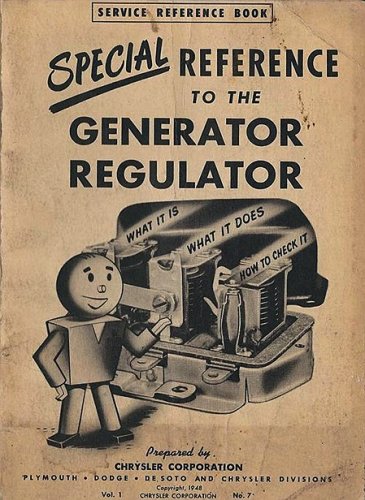Search the Community
Showing results for tags 'generator'.
-
Engine Sputter & System Charging; Engine runs fine & no charge.
Noah posted a topic in P15-D24 Forum
Hey all, I've got an issue I can't seem to figure out. Seems pretty odd to me and I can't even make sense of why it would happen. Motor is a 218CI Flathead six out of a '49 plymouth. It's installed in a '57 Dodge D100 pickup. The engine started running a bit rough, a bit of a sputter, when accelerating. Also, it did not want to start hot, wait 15-20 minutes and starts. The ammeter was broken and the battery died so I went ahead and replaced the ammeter, battery, generator (yes, I polarized it) , voltage regulator, coil, fuel pump, added a couple ground straps, reset the breaker points. I fired it up and it ran fine for about two miles, then almost instantly it started sputtering. When it was running fine it did not show a charge so I thought maybe I received a bunk ammeter. When it started sputtering, simultaneously it also started showing a nice charge. I thought it was a coincidence. I took it back to the shop and checked all the grounds, wiring resistance and connections and routing. All looked good. I took it out again and seemed to be running fine so I drove for about 20 minutes putting it through the paces, with no issues, EXCEPT, it's not showing a charge now, showing a slight draw. Finally got on the highway and at top end picked up a slight sputter. While limping back home the sputter got a bit worse. Also, need to mention simultaneously with the sputter returning, the ammeter now shows a charge. I can't place the relationship, anyone have any thoughts? Could it be the distributor? Points? I'm fairly certain it's an electrical issue due to the simultaneous misfires/sputtering aligned with the charge showing on the ammeter. Thanks in advance for taking the time to read this and respond. Located in North San Diego if anyone nearby wants to check it out. -
I came across these two short tutorials on how a mechanical voltage regulator functions in detail. Apparently there are two basic types depending on how the generator field winding is wired, type A and type B. Other than that, the two types are identical. I'm guessing Pilothouse Dodge trucks use something closer to type A. They explain how the three parts of a voltage regulator control charging the battery, how it prevents the battery from draining back to ground through the generator when generator voltage is low or zero, and how it prevents overcurrent and over overvoltage conditions from happening. Just good stuff to know. Type A Type B
-
- 2
-

-
- field
- circuit breaker
-
(and 8 more)
Tagged with:
-
Hi, I just got a 53 pilot house and got the generator rebuilt and a new voltage regulator put in. They both get really, really hot. What can I do? Thanks, Matt new guy
-
I am in need of some help on my 49 Chry, when looking at the generator from the rear where are the arm and field posts located? Reason being that there is no stamping to denote either post or it is under the band. as always thank you for your help
-
Hello all, Generator in my 1947 New Yorker can't keep up with the load when lights, radio and heater are on. Starter is turning slowly even when battery is fully charged. I believe that I have two matters to address: 1.Regarding generator- I would like to update to a positive ground one wire six volt alternator from Quality Power. 2.Regarding starter- since it seems like the starter is pulling too much power I need to get it overhauled - doesn't seem to be any MAX 4050's available now (if that is the right autolite starter for the straight eight). I am going to attach photos of the regulator in my car. From what I have read on this site installing an alternator does not appear difficult and after disconnecting the "A" and "F" poles on the regulator I should attach the alternator wire to the wire coming out of the regulator at the "B" pole. Diagrams made it look simple but when I looked under the hood the proximity of the relay and how its wiring may need to be modified with the new alternator has caused me to reappraise the "simplicity" of this job. Please take a look at the attached photos and diagrams - what will I need to do to the relay if I switch to an alternator? Also, what is the small cylinder on top of the generator? It is not in any pictures that I could find in the shop or parts manuals. Finally, any tips on a good place to send my starter to for a re-build? Many thanks and happy New Year!
-
I am attempting to identify a correct Auto-Lite generator for my 1941 Plymouth Special Deluxe (P-12). As I do not have the old one (it's a long story), I researched the specs and determined that it should be an Auto-Lite GDZ-4801-B. I have been unable to find this model but have found several with the GDZ-4801-A part number and other letters. Does anyone have a reference explaining what the letter means at the end of the Auto-Lite part number? Or, even more specifically, the difference between the A and B versions of this generator and whether the A version can be used in this vehicle? I reviewed several Auto-Lite references posted on this forum but none seem to explain the foregoing. Thanks!
-
Guys, I need a little help. I was given a rebuilt generator from a 40's or 50's MOPAR by a guy cleaning out his garage. It bolted right on my '48 Dodge, but when I went to hook it up, I found that the terminals are different and unmarked. I can't tell which is the field and which is the armature. My original generator's terminal were front and back oriented at the top rear of the generator housing. These are at the top rear, but are oriented at 11 o'clock and 1 o'clock as viewed from the rear. Anyone know which is which? Thanks.
-
Looking for a guesstimate of how long a B1B will run without an operating generator system. Would like to drive the truck in the upcoming 4th of July parade and not sure will have an operable genny system by then. Have been currently running the engine off a 12 volt battery, positive ground with a switched lead to the coil. Maximum run time has been 15 minutes or so to check operation of cooling system thermostat, etc. Anybody have a guess or experience with a failed generator system and still able to drive running off the battery only?
-

Give Your Electrical System A Quick Check Up, Watch Your Ammeter!
P15-D24 posted a blog entry in P15-D24's Website Blog
One of the quickest ways to get a quick health check on your electrical system is watch your ammeter! It will tell you all kinds of valuable information if you know how to read it! Most modern cars now use a voltmeter to provide limited information about your electrical system. Or even worse just a warning light to let you know your alternator has failed. Because voltmeters are now the norm the skill of interpreting the information the ammeter provides is becoming a lost art. Let’s walk through a driving sequence to understand what the ammeter will reveal about your electrical system. Entering the car your the ammeter should be reading "0", straight up. You may see a quick defection to the minus side if your have an interior light that comes on with opening the door. It's at "0" because you are not using any or generating any current (engine is not running). When you turn on the ignition you will see the needle move slightly to the minus (discharge) side indicating a discharge of a couple amps. This means your ignition system is getting power. When you hit the starter the ammeter will deflect sharply to the left (minus 20-30 amps) as the starter spins. The energy for the starter is being drawn straight from the battery. As the engine fires the ammeter will quickly move to the plus side (charging) of the gauge in the 20-30 amp range. The energy that was drawn down from the battery while starting is quickly being replaced by charging current from the generator. As you start driving the voltage regulator will manage the amount of charge needed to go back into the battery. After around five minutes of driving typically the battery will start to approaches full charge and you will see a reduction of charge rate down to 1-3 amps on the plus side. At this point the battery has fully recovered from the starter discharge and now the generator is putting out only enough current to maintain the charge. The voltage regulator manages the on-going charge rate. While your driving night time is coming and it is getting cooler. You turn on your headlights and start up the heater fan. Immediately you see the needle momentarily jump to the minus side, then come back to 1-3 amps on the charge side as the regulator manages the generator output to meet the increased demand. As you come to a stop sign and the engine speed drops, the ammeter will move sharply to the minus side, often 15-20 amps down. You notice the lights dim and the heater motor may slow. Right now your generator is not creating enough power to offset the increased load of the headlight and heater motor and is drawing backup power from the battery. This lack of sufficient power generation can fully discharge a battery if allowed to go for a long period. The short stop at the stoplight however, is not harmful. In fact, you can always bump the manual throttle to bring the idle up enough to stop the discharge. As soon as you accelerate from the stop the generator will again start generating sufficient current to replenish the energy pulled from the battery (expect a jump to 5-10 amps charge for a short period) before settling back to a trickle charge of a couple amps while driving. So how can you use if for some basic troubleshooting? When you first get in and step on the break pedal, the ammeter should deflect slightly to discharge as the brake lamp lights. This lets you know the battery has some charge. No deflection? Battery is probably dead or disconnected. Also when you turn on the key if you don't see a slight discharge indication your ignition is probably not connected or functional. If when turning on the key and immediate your have a full discharge (minus 35 amps) you have a dead short that needs to be repaired. Immediately turn off the key and begin trouble shooting to find the electrical short. Otherwise you risk the very real danger of a wiring fire. Might start your troubleshooting at the headlight switch as they have historically been trouble spots due to corrosion resistance in the connectors. If you are running and suddenly see a continuous discharge usually this indicates a voltage regulator issue. Try tapping the regulator case with a screwdriver handle to see if a relay is sticking and it starts charging again. On teh other hand if you see a continuous rate of high charge (> 20 amps) that never goes down you may have a battery starting to fail (it's not taking or holding a charge) or a voltage regulator failing. Either way it's time to troubleshoot the generator and regulator charging circuit. By watching the action of your ammeter your can easily tell if your electrical system is functioning correctly. It will tell you if you have a short, your battery is full charged, how fast it is charging and how much current your are consuming while driving. Compared to a voltmeter which simply gives system voltage, ammeters allow you active monitor your electrical system. Share what on the road lessons have you learned by paying attention to your ammeter!- 7 comments
-
- 6
-

-
- Generator
- Electrical System
-
(and 1 more)
Tagged with:
-
I have a 1953 fargo half ton pickup with the straight 6. recently the generator has stopped making a charge. it is a 12 volt shunt generator part number 1770754 it also has a autolite number of gjc-7012-a serial number of 9-1001851. it there a way to rebuild it or should I just try and find a new one.. also where would I find one... I have some pictures of the generator if that helps..
-
I have a 52 b3b and am having voltage regulator or generator problems. I think the generator is working. When I disconnect the wires from the generator and put a volt meter from the armature to ground and run a jumper wire from the battery negative terminal to the field terminal it appers to be charging. My voltage regulator is not marked for Field or armature. . Is the bottom terminal on the left of voltage regulator field or armature. The terminal on the right should be battery. When I go to dodge pilot house knowledge it shows all three terminals on the left side as you are looking at the regulator with the field terminal in the middle.Basicly batt field arm. Does any know if mine is field arm or arm field on the left side. Any help would be appreciated. I tried posting a picture but was not able to as it was to big and I do not know how to make it smaller. Larry
-
I took my woodie to a car show in early June and came home and put it in the garage, as usual. I tried to start it about three weeks later and the battery was deaded than a door nail. It wouldn't even budge the dash indicator, no lights, no dome light, no horn. Really dead. The battery is a 6v Optima I bought in August 2010. Has been great with tons on cranking power. I checked the headlights, which were off, and looked for anything else I might have forgotten that could have drained the battery, but nothing seemed to be on. With the ignition off, there really isn't much else on my car that can remain on. Very perplexing. The battery store confirmed the battery was absolutely dead, so the assumption is something is on that drained it. They revived it by putting a good Optima in-line with mine and put a charger on it (how the manufacturer recommends reviving a dead Optima). Seems fine now, but I am leary. The variable that concerns me is that I had a generator issue and swapped out parts from a spare and replaced the brushes at the same time. Then, the car show maybe two or three weeks later. I show no drain on the battery when hooked up now, and dash gauge goes way to charge for the first few minutes of driving, then settles a little right of the middle, but this still concerns me. I have a couple questions: The brushes are new and showed no signs of cracked or flaking insulation. Is there something I might have done to the generator to cause an intermitant short? If that were the case, would I not see that the battery was being drawn by looking at the dash guage with the car off? Could the armiture be shorting only at a certain position and is there a way I can test this? I have avoltage meter, but except for the vary obvious stuff, I am not adept at using it. Kind of like my wife with a screw driver. Is there a reliable way to tell if I have a constant drain with the car off? I have seen many threads on chasing down electrical issues on the forum. And electrical is not my strong suite (if i have one). But this car has been very reliable eletrically, so I am looking for the obvious stuff first. I have also seen a few comments on the web that the newer Optimas occassionally do have some kind of sudden death issues that nobody seems to understand, so it COULD be the battery, but I am not there yet.
-
Hi Seems the final hurdle on my rewiring journey is now facing me. The generator doesn't seem to be putting anything out... Before my rewire of the car, when the key was switched on, the ammeter went just left of '0', indicating draw from the coil off the battery. Once the car started, the ammeter always went over to the '+' side, showing charging back into the battery. Even at a low idle, it was always on the '+' side. Of course, after plenty of cranking etc, he ammeter read higher at first, and then went down, indicating that the regulator was doing its job. Unfortunately, this isn't happening now.... I have the generator wires hooked up correctly - field terminal (small terminal on the generator) to the field 'F' terminal on the regulator, Armature cable to the 'A' terminal on the reg. Now I've researched the heck out of the forum archives on this one. I see there is always plenty of discussion about polarizing the generator via the regulator - however this is normally when the gen has been serviced. Mine didn't get taken out of the car during the rewire...so shouldn't need this? I also see a test whereby the field wire can be removed from the regulator and taken to ground - this should peg the ammeter to the '+' side of the gauge. I've done this test - nothing. no movement in the gauge at all. The other indcators which alert me are that with the headlight switch pulled on, the ammeter goes right down into '-' territory and stays there, no matter the revs...and the instrument lights (yep - I've got those now!!) don't brighten with any revving of the engine. Seems something is amiss somewhere...? Is there a way that a multimeter can be hooked up to test for current/amp/voltage off the generator when the engine is running. I can't quite work out which way to read this circuit... I've checked all the terminals - seem tight and have good connections. Any suggestions for tests, or perhaps restate the tests that I need to be doing to see the problem. I can't believe that the generator would stop working just because of a re-wire elsewhere - like I said, I didn't touch it. How does one 'test' a regulator?











